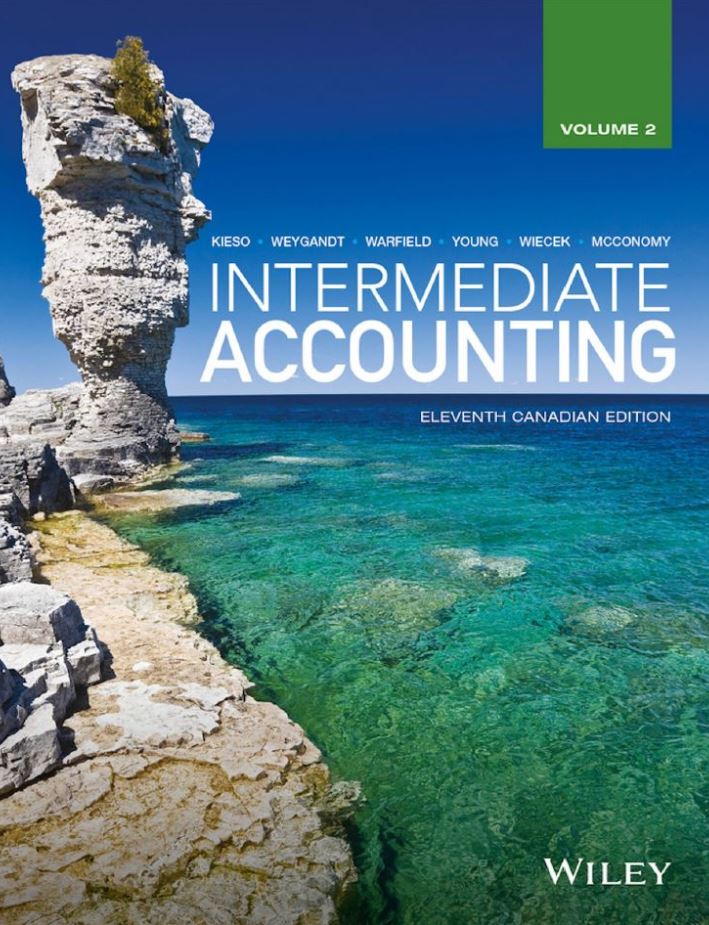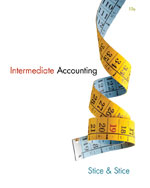Test Bank For Intermediate Accounting 11th Canadian Edition Volume 2 by Donald E. Kieso
Original price was: $55.00.$26.00Current price is: $26.00.
Test Bank For Intermediate Accounting 11th Canadian Edition Volume 2 by Donald E. Kieso is a great resource for accounting students. It provides students with a variety of practice problems, as well as explanations of the principles behind each problem.
The Test Bank also includes a variety of real-world examples that illustrate how the principles of accounting can be applied in practice. In addition, the Test Bank includes a glossary of terms, so that students can quickly look up unfamiliar terms. Overall, the Test Bank is an excellent resource for accounting students at all levels of study.
Digital item No Waiting Time Instant Download
ISBN-13:9781119048541 978-1-119-04854-1
ISBN-10:1119048540 1-119-04854-0
Description
Test Bank For Intermediate Accounting 11th Canadian Edition Volume 2 by Donald E. Kieso
CHAPTER 13
NON-FINANCIAL AND CURRENT LIABILITIES
CHAPTER STUDY OBJECTIVES
1. Understand the importance of non-financial and current liabilities from a business perspective. Cash flow management is a key control factor for most businesses. Taking advantage of supplier discounts for prompt payment is one step companies can take. Control of expenses and related accounts payable can improve the efficiency of a business, and can be particularly important during economic downturns.
2. Define liabilities, distinguish financial liabilities from other liabilities, and identify how they are measured. Liabilities are defined as present obligations of an entity arising from past transactions or events that are settled through a transfer of economic resources in the future. They must be enforceable on the entity. Financial liabilities are a subset of liabilities. They are contractual obligations to deliver cash or other financial assets to another party or to exchange financial instruments with another party under conditions that are potentially unfavorable. Financial liabilities are initially recognized at fair value, and subsequently either at amortized cost or fair value. ASPE does not specify how non-financial liabilities are measured. However, unearned revenues are generally measured at the fair value of the goods or services to be delivered in the future, while others are measured at the best estimate of the resources needed to settle the obligation. Under IFRS, non-financial liabilities other than unearned revenues are measured at the best estimate of the amount the entity would rationally pay at the date of the statement of financial position to settle the present obligation.
3. Define current liabilities and identify and account for common types of current liabilities. Current liabilities are obligations that are payable within one year from the date of the statement of financial position or within the operating cycle if the cycle is longer than a year. IFRS also includes liabilities held for trading and any obligation where the entity does not have an unconditional right to defer settlement beyond 12 months after the date of the statement of financial position. There are several types of current liabilities. The most common are accounts and notes payable, and payroll-related obligations.
4. Identify and account for the major types of employee-related liabilities. Employee-related liabilities include (1) payroll deductions, (2) compensated absences, and (3) profit-sharing and bonus agreements. Payroll deductions are amounts that are withheld from employees and result in an obligation to the government or other party. The employer’s matching contributions are also included in this obligation. Compensated absences earned by employees are company obligations that are recognized as employees earn an entitlement to them, as long as they can be reasonably measured. Bonuses based on income are accrued as an expense and liability as the income is earned.
5. Explain the recognition, measurement, and disclosure requirements for decommissioning and restoration obligations. A decommissioning, restoration, or asset retirement obligation (ARO) is an estimate of the costs a company is obliged to incur when it retires certain assets. It is recorded as a liability and is usually long-term in nature. Under ASPE, only legal obligations are recognized. They are measured at the best estimate of the cost to settle them at the date of the statement of financial position, and the associated cost is included as part of the cost of property, plant, and equipment. Under IFRS, both legal and constructive obligations are recognized. They are measured at the amount the entity would rationally pay to be relieved of the obligation and are capitalized as part of PP&E or to inventory, if due to production activities. Over time, the liability is increased for the time value of money and the asset costs are amortized to expense. Entities disclose information about the nature of the obligation and how it is measured, with more disclosures required under IFRS than ASPE.
6. Explain the issues and account for unearned revenues. When an entity receives proceeds in advance or for multiple deliverables, unearned revenue is recognized to the extent the entity has not yet performed. This is measured at the fair value of the remaining goods or services that will be delivered. When costs remain to be incurred in revenue transactions where the revenue is considered earned and has been recognized, estimated liabilities and expenses are recognized at the best estimate of the application of the matching concept.
7. Explain the issues and account for product guarantees and other customer program obligations. Historically, an expense approach has been used to account for the outstanding liability, but some recent standards have moved toward the revenue approach. Under the expense approach, the outstanding liability is measured at the cost of the economic resources needed to meet the obligation. The assumption is that along with the liability that is required to be recognized at the reporting date, the associated expense needs to be measured and matched with the revenues of the period. Under the revenue approach, the outstanding liability is measured at the value of the obligation. The proceeds received for any goods or services yet to be delivered or performed are considered to be unearned at the point of sale. Until the revenue is earned, the obligation—the liability—is reported at its sales or fair value. The liability is then reduced as the revenue is earned.
8. Explain and account for contingencies and uncertain commitments, and identify the accounting and reporting requirements for guarantees and commitments. Under existing standards, a loss is accrued and a liability recognized if (1) information that is available before the issuance of the financial statements shows that it is likely (or more likely than not under IFRS) that a liability has been incurred at the date of the financial statements, and (2) the loss amount can be reasonably estimated (under IFRS, it would be a rare situation where this could not be done). An alternative approach likely to be required in new standards being developed by the IASB is described in the Looking Ahead section of the chapter.
Guarantees in general are accounted for similarly to contingencies. Commitments, or contractual obligations, do not usually result in a liability at the date of the statement of financial position. Information about specific types of outstanding commitments is reported at the date of the statement of financial position.
9. Indicate how non-financial and current liabilities are presented and analyzed. Current liability accounts are commonly presented as the first classification in the liability section of the statement of financial position, although under IFRS, a common presentation is to present current assets and liabilities at the bottom of the statement. Within the current liability section, the accounts may be listed in order of their maturity or in order of their liquidation preference. IFRS requires information about and reconciliations of any provisions. Additional information is provided so that there is enough to meet the requirement of full disclosure. Information about unrecognized loss contingencies is reported in notes to the financial statements, including their nature and estimates of possible losses. Commitments at year end that are significant in size, risk, or time are disclosed in the notes to the financial statements, with significantly more information required under IFRS. Three common ratios used to analyze liquidity are the current, acid-test, and days payables outstanding ratios.
10. Identify differences in accounting between IFRS and ASPE and what changes are expected in the near future. Private enterprise and international standards are substantially the same. However, there are some classification differences. ASPE does not address “provisions,” and there are differences related to which decommissioning and restoration liabilities are recognized and how the costs are capitalized, and how the probability and measurement criteria are applied to contingencies. In addition, requires considerably more disclosure. Looking ahead, revisions to the existing standards are being proposed by the IASB and FASB that will likely be applied, at least in part, under CICA Handbook, Part II in the future. The major changes relate to the recognition and measurement standards for non-financial liabilities.
Multiple Choice—Conceptual
Answer No. Description
c1.Essential characteristics of liabilities
c2.Constructive obligation
b3.Recognition and accounting for financial liabilities
a4.Classification of notes payable
d5.Zero-interest-bearing notes
c6.Refinancing of long-term debts
b7.Identify item that is not a current liability.
c8.Identify the current liability.
d9.Classification of stock dividends distributable
a10.Goods and Services Tax
b11.Identify current liability.
c12.Accounting for GST
a13.Provincial Sales Tax
b14.Corporation income tax
a15.Knowledge of accounts payable
d16.Current liabilities in general – determine false statement
c17.Determine employer’s payroll costs
b18.Accumulating rights to benefits
c19.Accrual of liability for compensated absences
b20.Non-accumulating rights to benefits
d21.Methods of calculating employee bonuses
c22.Definition of a provision
d23.Recognition of an asset retirement obligation
c24.Recognition of an asset retirement obligation
a25.Recording accretion expense for ARO
c26.Revenue approach for product guarantees
d27.Determine false statement regarding warranties
b28.Accounting for premiums and coupons
d29.IFRS re customer loyalty programs
c30.Recognition of contingencies (ASPE)
a31.Recognition of contingencies (IFRS)
d32.Accrual of contingent liability
c33.Disclosure of commitments
d34.Determine range of loss accrual.
d35.Acid-test ratio elements
c36.Days payable outstanding elements
b37.Essential characteristics of liabilities
c38.Proposed amendments regarding provisions and contingencies
Multiple Choice—Computational
Answer No. Description
b39.Adjusting entry for zero-interest-bearing note
d40.Journal entry for payment of interest-bearing note
b41.Determine amount of short-term debt to be reported.
d42.Determine amount of short-term debt to be reported.
b43.Calculate accounts receivable including sales taxes.
c44.Calculate cost of purchase for own use.
d45.Payment of GST
c46.Adjusting entry for corporate income tax
d47.Determine amount of short-term debt to be reported.
c48.Calculate accrued interest payable.
c49.Calculate HST collected.
b50.Calculate payroll tax expense.
b51.Calculate vacation pay expense to be reported.
c52.Calculate accrued vacation pay liability.
b53.Calculate net pay.
a54.Calculate accrued salaries payable.
b55.Accrual of payroll taxes
d56.Entry for asset retirement obligation
b57.Entry for asset retirement obligation accretion
b58.Calculate asset retirement obligation.
c59.Adjusting entry for unearned revenue
b60.Determine current and long-term portions of debt.
a61.Expense approach to warranty
a62.Revenue approach to warranty
c63.Calculate warranty liability (expense approach).
a64.Calculate liability for unredeemed coupons.
b65.Calculate unearned service contract revenue.
c66.Calculate liability from unredeemed trading stamps.
b67.Determine amount to accrue as a loss contingency.
d68.Determine amount to accrue as a gain contingency.
c69.Calculate quick (acid-test) ratio.
d70.Calculate current ratio.
a71.Calculate days payables outstanding.





Be the first to review “Test Bank For Intermediate Accounting 11th Canadian Edition Volume 2 by Donald E. Kieso”